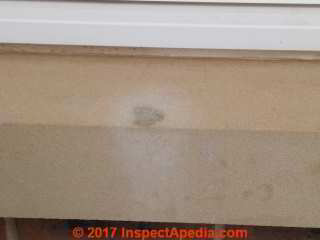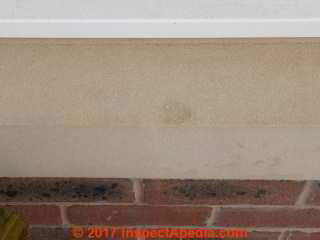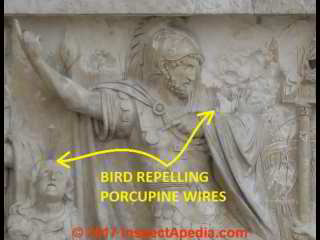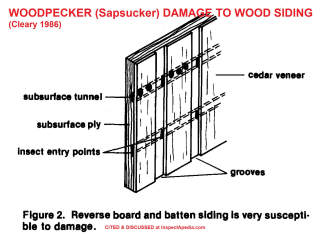 Cleaning & Prevention of Bird Damage, Droppings, Stains
Cleaning & Prevention of Bird Damage, Droppings, Stains
on building & other urfaces
- POST a QUESTION or COMMENT about the best methods to clean stone surfaces
How to remove bird dropping stains & how to keep birds off of buildings:
This article describes removal and preventing stains on building exterior surfaces from bird droppings.
We also discuss bird repellent systems: how to keep birds from roosting on or pecking at your structure.
We include links to references & reseach on bird dropping cleanup and on methods used to keep birds off of building surfaces.
Our page top photo shows woodpecker damage to wood siding on a New York home. Woodpeckers may be hammering holes in your home to find insects or just because they like the sound as their local signal. Reverse board and batten siding and similar wood siding products are particularly vulnerable to sapsucker woodpecker damage (Cleeary 1986).
InspectAPedia tolerates no conflicts of interest. We have no relationship with advertisers, products, or services discussed at this website.
- Daniel Friedman, Publisher/Editor/Author - See WHO ARE WE?
Bird Damage & Bird Dropping Stains
 Question: what's the best way to get rid of blackberry-stained bird droppings
Question: what's the best way to get rid of blackberry-stained bird droppings
Hi there from Derby in the UK,
Congratulations on your InspectApedia site, it's a fantastic wealth of information.
I have a specific issue that I don't believe has been covered. I was looking for some general guidance and wondered if it might be of use to include it (or part of it), on your site. Feel free to use any information or pictures contained herein.
[Click to enlarge any image]
Problem: We have a house that is less than 18months old that has stone window sills. This summer a bird deposited a blackberry-fuelled dropping on one of the sills, leaving a purple stain. I tried to jet-wash it out but it left a black mark. ... I treated what was left with some white vinegar.
Now I have both the black mark along with newly discoloured stone around it, it's a mess (see attached pictures).
I didn't realise the stone would be so sensitive!
Questions: How should have I treated the original stain? Have I irreversibly damaged the sill with the vinegar? Is there anything I can do now to treat the area, or even recolour the whole sill in any way?
Any insight much appreciated! - Anonynmous by private email 2017/08/23
Followup detail:
The house is 18 months old (we bought it new). However, the neighbourhood isn't finished yet so the dust from the ongoing works continually spreads a fine layer of dust over everything.
So although the stone is more or less new, I imagine it will have already collected a pretty high degree of airborne debris.
Reply: standard cleaning procedure to remove bird droppings
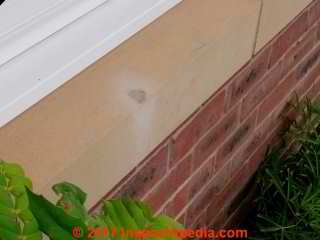 Derby, pretty much smack in the center of Britain has a general concern with air pollution, as doubtless you already know. http://www.derby.gov.uk/transport-and-streets/air-quality/managing-air-quality-derby/
Derby, pretty much smack in the center of Britain has a general concern with air pollution, as doubtless you already know. http://www.derby.gov.uk/transport-and-streets/air-quality/managing-air-quality-derby/
I don't know how close you are to busy roadways - a significant contributor to pollutants.
Settling out out on building surfaces particulates, especially diesel fuel, road dirt, tire particles add colour. Another serious air pollutant, NO2 probably doesn't have much affect on surfaces.
Without testing (that is not cost-justified) we can but guess at the constituents of particles that have, over years (how old is your home?) settled into the stone window sills in your photos.
But I suspect the general beige hue is a combination of organic and inorganic airborne debris, perhaps further oxidised by sunlight. Those form a colour base onto which the birds have left you their little gift.
There are then at least three discolouring effects besides the airborne contaminants and solar photo-oxidation: the bird droppings (worse with blackberry juice) themselves leave a colour, the droppings are acidic (containing uric acid) and can etch a surface, and of course there are the effects of cleaning.
The stain you describe is a difficult problem to manage and one I've experimented with. Using any cleaner, even plain water, risks leaving a lighter spot on the stone when you scrub off bird poop.
I haven't done chemical tests but I think that
1. Even just water, if scrubbed, say with a toothbrush, will remove particles that have settled into the concrete or brownstone sill on a building, thus leaving a lighter colour in the area of scrubbing.
2. Acids in bird doo work their own hell on the surface. That's why I don't like to leave droppings un-washed on a car: come back months later, wash it off, and you'll see the paint has a noticeable etched area.
3. And as you note, blackberry juice itself is a powerful stain.
Cleaning off Blackberry-Stained Bird Droppings
For a blackberry stain a common remedy involves these steps (my approach, others don't think all my details are necessary)
1. Brush off as much blackberry-laden bird poop as you can with the surface dry. I don't wet it because doing so will spread the peroxide of the next step outside the stain area.
2. Apply hydrogen peroxide, preferably with a cotton swab and with care to try to keep the peroxide just in the dark area of the stain and leave it may be 10 minutes or so - watch the stained area to see when it is almost but not entirely gone as I want to try to avoid over-treating or over-bleaching. (Peroxide is an oxidant).
3. Blot off the peroxide with a paper towel, again trying to not spread it outside the stain.
4. Wash off the area liberally with water, then with vinegar to neutralize the peroxide, then more water.
5. Inspect: if more bleaching is needed wait for the stain to dry, then repeat the process with a lighter touch of peroxide.
In the future, if you spot a fresh bird dropping and clean it off with simple water soon-enough after it falls, staining will be minimised - but to be fair I realise that no normal person is going to waste their life standing guard with a garden hose.
I've also used bleach in a similar procedure on wood floors.
There I sat right by the stain and took great care to remove the bleach before it had over-bleached the wood. Still I often had to touch-up the bleached spot with a stain to match the surrounding floor colour. That + a final top clear coating left the floor looking perfect.
What to Do Where Cleaning has Left Light Areas on the Stonework
For your stonework, the question is what to do now. Options include
1. Nothing, just wait; over time the stone exposed to the elements will lose some of the contrast in the area you cleaned.
2. Try the procedure I gave above to reduce the black area in the middle of the light area where you cleaned. Then try cleaning the whole stone sill surface with a soft bristle brush and a detergent solution so you bring the surround lighter to match the bleached out spot.
Take care to rinse copiously to avoid accidentally streaking the wall around and below the work area.
Reader follow-up:
[Regarding the role of air pollutants in the U.K. in the formation of building stains], yes we definitely have that general problem here, most people don't realise the damage it can do to car paintwork
Follow-up question: What grade of hydrogen peroxide should I use? There seems to be a wide range out there from 3% to 35%.
Reply: 3% hydrogen peroxide
I reviewed multiple amateur and scholarly articles on this and not one of them mentioned a concentration of hydrongen peroxide.
The most-common drugstore medical-use (wound cleaning) hydrogen peroxide concentration is 3%. I'd wager that most people doing such cleanups just go to a local apothecary to pick up what's available. So I'd go with the 3%. It's always clever to start with the most-mild approach to cleaning anyway.
Also there is an alternative fancier stone-cleaning and bird dripping cleanup recipe is recommended by some: water, ammonia, dish soap and hydrogen peroxide.
Reader Follow-up:successful results of bird dropping stain removal efforts
 I began treating the mark with the 3% hydrogen peroxide (which cost me £2.75 delivered http://www.ebay.co.uk/itm/131958607376 ), in the way advised (carefully swabbing it on with cotton buds, leaving on for 10 minutes, rinsing/washing the area after each application, allowing to dry and then repeating).
I began treating the mark with the 3% hydrogen peroxide (which cost me £2.75 delivered http://www.ebay.co.uk/itm/131958607376 ), in the way advised (carefully swabbing it on with cotton buds, leaving on for 10 minutes, rinsing/washing the area after each application, allowing to dry and then repeating).
[Click to enlarge any image]
After about 3 rounds of this it didn't seem to be doing very much, so I took to simply swabbing the area with the hydrogen peroxide, leaving it to dry and then adding more until the stain had faded. I counted somewhere between 8-10 applications in total.
After 6-7 rounds I appeared to hit a plateau where there was no further improvement to be had, so I stopped there.
You can see the side-by-side comparison that there has been a significant improvement. The mark has been bleached out I'd say about 75% and I assume it will continue to fade over time due to sun bleaching, general weather and the sill becoming dirty.
However, I was still left with the light area that the household white vinegar spray had caused. [Photo below]
I dealt with this by spraying the rest of the sill to bring it up to the same shade. I had to do this twice and it seems to have balanced out relatively well (see the before - above, and after photo - below that are taken from a couple of feet away).
Other dark marks from manufacture/build now show up a bit more clearly on the sill but they have always been there and I believe they will become less visible as the sill naturally dusts up/weathers.
Overall things are a lot better than when I started. It isn't perfect but I'm satisfied to the degree that I don't feel the need to do anything further. So I thank you for your advice and I hope that the pictures and chat are of some use for your website.
- Anonynmous by private email 2017/09/18
Keep Birds Off of Urban Building Ledges & Stonework
 There are hundreds of scholarly and other articles on bird repllent methods for buildings. We cite some we like later in this page.
There are hundreds of scholarly and other articles on bird repllent methods for buildings. We cite some we like later in this page.
The most-common procedure you'll see everywhere, and that you will not want to do at your home's window-sills is the installation of an array of spikes that makes the surface so uncomfortable that your birds rest on your neighbour's home instead of yours.
Above: an electrified bird repelling system on the facades of palacios along the Grand Canal in Venice. I'm not a fan of electrocuting birds that land on my building's ledges.
[Click to enlarge any image] Below: close-up of the electrified bird repellent system in Venice.
Watch out: in most residential building environments you should not normally have a reason to use bird repelling systems that injure or kill birds nor any other wildlife.
And such bird murder is also unnecessary.
The most-effective method for deterring roosting birds from urban homes is the use of scaring devices. (Barnes 1997).
Really? In the Mid-Hudson valley of New York where there are extensive and large plots of grape vines grown for local wineries, we've seen the use of scaring devices like loud cannons intended to drive off birds who othewise dine on the grapes. We'e seen birds in essence holding their ears shut while dining away under banging canons. Noise-scaring devices as bird repellents seem to work best at the start of the growing season but before harvest it's often the case that birds have simply learned to tolerate the scaring-device. [Editor]
More common are non-electrified bird repellent spikes and wires.
Best Way to Keep Birds From Roosting on Urban Buildings
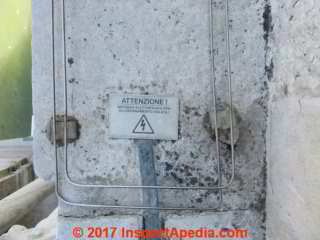 To Install a permanent bird-repellent system consider porcuipine wires or angled covers for othewise flat roosting locations.
To Install a permanent bird-repellent system consider porcuipine wires or angled covers for othewise flat roosting locations.
The following two excerpts are from Barnes (1997) cited below.
The best long-term solution is to alter the structure to prevent the birds from landing. When the roosting surface is a ledge, this may be accomplished by placing a metal covering or board over the ledge at a 45-degree angle (or greater).
Make sure the ends are closed to prevent entry. Another method of deterring birds from these locations is to install “porcupine wires.” These short, heavy wire prongs stick out at various angles and prevent birds from landing.
The most effective method of dispersing small roosts is to use scaring devices.
Really? OPINION: Well yes scaring birds can work, for a time. Bird scaring systems include sound, booms, blasts, water sprays, and chemical agents (typically permitted application only by certified pest control operators).
But most bird-scaring methods are not something you'd live with in a residential setting, such as cannons or water sprays.
And the long-term effectiveness of bird scaring methods is questionable without a constantly-alert management plan that varies the scare and times it with care. (Barnes 1997).
Bird Control Systems: Perch Repellents & Porcupine Wire Systems
Photo: bird replling porcupine wires installed on the frieze of a building in Campo San Maurizio, Venice, Italy.
[Click to enlarge any image]
- Bird-B-Gone Inc., 15375 Barranca Pkwy # D Irvine, California 92618 USA, Tel: 866-308-7597 Website: https://www.birdbgone.com bird control products, bird spikes, plastic and stainless steel
- Ecopic Corporation 725 South Adams, Suite 270 Birmingham, MI 48009 USA, Tel: 248-647-0505 Website: http://www.ecopic.com mechanical bird control products, perch repellents, porcupine wires
- J. T. Eaton & Company 1393 Highland Road Twinsburg, OH 44087 USA, Tel: 800-321-3421 Website: http://www.jteaton.com 4 The Birds® chemical perch repellents for birds
- Nixalite of America, Inc., 1025 16th Ave East Moline, IL 61244 USA, Tel: 888-624-1189, Website: https://www.nixalite.com pest & wildlife control products. Nixaliate's Premium Model S stainless steel Bird Spike system is sold in two-foot strips.
- Oldham Chemical Company, Inc. Tel: 800-888-5502 Website: http://www.avitrol.com Avitrol® chemical bird scaring agent, for certified applicators only.
- Tanglefoot® Tanglefoot Company 314 Straight Avenue, SW Grand Rapids, MI 49504 USA, Tel: 616-459-4139 Website: http://www.tanglefoot.com, chemical perch repellents
- Shaw Steeple Jacks, Inc. 2710 Bedford Street Johnstown, PA 15904 USA, Tel: 1-800-897-8008 Website: http://www.churchbuilders.com , Cat Claw®
- Wildlife Control Technology 2501 N. Sunnyside Fresno, CA 93727 USA, Tel: 800-235-0262 Website: http://www.wildlife-control.com, bird control netting products
Also see ANIMAL ENTRY POINTS in BUILDINGS where we describe means to deter various animals who might otherwise enjoy your home. There we also warn
Watch out: Cryptococcus infection (cryptococcosis): (from bird droppings), at primary risk are people with compromised immune system but normal adults can also be infected by inhalation of Cryptococcus neoformans, leading to a form of meningial encephalitis.
Cryptococcosis is a fungal disease caused by Cryptococcus neoformans or Cryptococcus gatti. Most people don't get sick from cryptococcosis but some may be particularly vulnerable.
Bird Damage Prevention & Bird Repellent Systems for Buildings
Sketch: typical pattern of sapsucker woodpecker damage in plywood type siding (Cleary 1986).
Effective chemical or mechanical bird repellents do not have to be lethal to be effective. Salmon (2006) points out that some wildlife and pest control chemicals and treatments designed for agricultural use are not appropriate nor safe for home use.
While some bird repellents may not be effective for your situation, (Duarte 2011) & (Werner 2005), others can be effective and non-lethal (Belant 1997).
- Alderson, Caroline, and Albert Greene. "Bird-Deterrence Technology for Historic Buildings." APT bulletin 26, no. 2/3 (1995): 18-30.
- Barnes, Thomas G., and Bernice U. Constantin, MANAGING URBAN PEST BIRD PROBLEMS IN KENTUCKY [PDF] University of Kentucky Cooperative Extension Service (1997). retrieved 2017/08/24, original source: http://www2.ca.uky.edu/forestryextension/Publications/FOR_FORFS/FOR62.pdf
- Belant, Jerrold L., Paul P. Woronecki, Richard A. Dolbeer, and Thomas W. Seamans. "Ineffectiveness of five commercial deterrents for nesting starlings." Wildlife Society Bulletin (1998): 264-268.
- Belant, J.L., Seamans, T.W., Dolbeer, R.A. and Woronecki, P.P., 1997. Evaluation of methyl anthranilate as a woodpecker repellent. International Journal of Pest Management, 43(1), pp.59-62.
Abstract:
We evaluated the effectiveness of ReJex-iTTM TP-40, containing 40% methyl anthranilate (MA) for deterring woodpeckers from food and from damaging wood sidings of buildings. During December 1993- February 1994 we conducted three 2-week trials at four sites using six pairs of feeders containing untreated or TP-40- treated suet (5 .0, 2.5, or 1.25% g/g). We then placed 10 (1995) and four (1996) pairs (1 each TP-40-treated and control) of boxes with wood siding containing untreated suet at seven and four sites with known woodpecker activity for 2- 3 weeks to assess damage to the siding.
We also applied TP-40 to woodpecker-damaged wood siding of 14 residential buildings during 1994- 1996. Suet-eating birds, primarily downy woodpeckers ( Picoides pubescens Linnaeus), were repelled ( P < 0.01) by treated suet at all concentrations compared with untreated suet.
By contrast, damage (primarily by downy woodpeckers) to wood siding on untreated and TP-40-treated boxes was similar ( P 0.32) in both years. Also, 5 of 10 buildings treated with TP-40 received woodpecker damage in areas treated previously.
We conclude that TP-40 deters woodpeckers from food but does not reduce woodpecker damage to wood siding. This difference in repellency is likely to have been a consequence ofrapid degradation ofTP-40 from siding (49% in 3 days) and the fact that woodpeckers do not ingest wood, which minimized their exposure to TP-40.
We conclude that chemical repellents will generally be ineffective in reducing woodpecker damage to wood, and that other techniques including exclusion, frightening devices, and alternate forms of wood siding (e.g. wood composites) should be developed. - Bishop, J., H. McKay, D. Parrott, and J. Allan. REVIEW OF INTERNATIONAL RESEARCH LITERATURE REGARDING THE EFFECTIVENESS OF AUDITORY BIRD SCARING TECHNIQUES AND POTENTIAL ALTERNATIVES Food and Rural Affairs, York, UK (2003).
- Bomford, Mary, and Peter H. O'Brien. "Sonic deterrents in animal damage control: a review of device tests and effectiveness." Wildlife Society Bulletin (1973-2006) 18, no. 4 (1990): 411-422.
- Brittingham, Margaret C., & Shannon T. Falker, CONTROLLING BIRDS AROUND FARM BUILDINGS [PDF] Wildlife Damage Control Booklet, Penn State, College of Agricultural Sciences, support from the Wild Resource Conservation Fund, retrieved 2017/08/24, original source: http://icwdm.org/Publications/pdf/Birds/birdcontrolfarmbuildgPSU.pdf
- Cleary, Ed, and Terry A. Messmer. WOODPECKERS [PDF] (1986). USDA & North Dakota State University, Fargo ND, Integrated Pest Management, Cooperative Extension Service
- Cummings, John L., Patricia A. Pochop, James E. Davis Jr, and Heather W. Krupa. "Evaluation of Rejex-It AG-36 as a Canada goose grazing repellent." The Journal of wildlife management (1995): 47-50.
- Duarte, Jesús, Miguel A. Farfán, J. Mario Vargas, and Raimundo Real. "Evaluation of wires as deterrents for preventing house martin nesting on buildings." International journal of pest management 57, no. 2 (2011): 147-151.
Abstract:
We tested the effectiveness of wires in preventing house martins (Delichon urbica) from constructing nests on buildings. Their nests were removed after each of two breeding seasons, wires were installed, and nest relocation was monitored during the following breeding season. Deterrents were considered as successful if the nests were displaced to new sites and as a failure if the nests were relocated in their original places, even if these were constructed on the wires.
In the control, martins relocated 89.3% of their nests within the same location rather than in new locations. In the treatment there was a 45% decrease in colony size, a failure rate of 77.7% and a displacement rate of 22.2% in the first year. During the second year, there was an 82.5% increase in colony size, a 45.5% failure rate and a 54.5% displacement rate.
The wires did not have a significant effect on displacements during the first year but did have such an effect during the second year. We conclude that wires are not an effective method for preventing house martins from nesting. - Fitzwater, William D. "Solutions to urban bird problems." (1988).
Abstract:
A survey of municipalities across the country indicated that pigeons were the most widespread aerial nuisance in urban areas. These were followed in order by: blackbirds, starlings, house sparrows, woodpeckers, crows/ravens, swallows/swifts, waterfowl (Canadian geese, mallards, and coots), and gulls.
With somewhat lesser frequency were robins, vultures, raptors, herons/egrets, mockingbirds, waxwings, and monk parakeets. Local bird problems were mostly handled by: USDA-APH1S-ADC, Health Department, City/County Animal Control, Landowner/householder, PCO, State Wildlife Agency, Police Department, and Mayor's office. - Kassa, Hailu, and Willaim B. Jackson. "Mesurol as a bird repellent on grapes in Ohio." In Bird Control Seminars Proceedings, p. 9. 1979.
- Lucid, Vincent J., and Roy S. Slack. Handbook on Bird Management and Control. Terrestrial Environmental Specialist Inc Phoenix NY, 1980.
Abstract:
This handbook was prepared to provide information to Air Force pest managers on hazardous and pest bird control. It discusses bird control in hangars, on airfields, and at other base locations. A systematic approach for surveying and determining control methods for bird problems is provided and legal aspects of bird control are discussed. Chapters two through eight have review questions to help the pest manager evaluate his proficiency in each subject area. A slide/tape presentation was prepared corresponding with information in this handbook. Copies are available for loan from Major Command Entomologists and the Air Force Engineering and Services Center. (Author) - Salmon, Terrell P., and Robert E. Lickliter. Wildlife pest control around gardens and homes. Vol. 21385. UCANR Publications, 2006.
- Werner, Scott J., H. Jeffrey Homan, Michael L. Avery, George M. Linz, Eric A. Tillman, Anthony A. Slowik, Robert W. Byrd, Thomas M. Primus, and Margaret J. Goodall. "Evaluation of Bird Shield™ as a blackbird repellent in ripening rice and sunflower fields." Wildlife Society Bulletin 33, no. 1 (2005): 251-257.
Abstract:
Chemical repellents sometimes can provide a nonlethal alternative for reducing wildlife impacts to agricultural production. In late summer and autumn 2002, we evaluated Bird Shield™ (active ingredient: methyl anthranilate, Bird Shield Repellent Corporation, Spokane, Wash.) as a blackbird (Icteridae) repellent in Missouri rice fields and North Dakota sunflower fields. We selected 5 pairs of ripening rice fields in southeastern Missouri and randomly allocated treatments (treated and control) within pairs.
The repellent was aerially applied by fixed-winged aircraft at the recommended label rate and volume (1.17 L Bird Shield/ha and 46.7 L/ha, respectively); 1 field received 2X the label rate. We observed no difference in average bird activity (birds/minute) between treated and control fields over the 3-day post-treatment period (P = 0.503). We used reversed-phase liquid chromatography to quantify methyl anthranilate residues in treated fields. The maximum concentration of methyl anthranilate in rice samples was 4.71 µg/g.
This concentration was below reported threshold values that irritate birds. In North Dakota we selected 6 pairs of sunflower fields used by foraging blackbirds. We randomly selected 1 field from each pair for 2 aerial applications of Bird Shield at the label-recommended rate ∼1 week apart. The remaining 6 fields served as controls. Daily bird counts, starting the first day of application and continuing for 5–7 days after the second application, showed similar numbers of blackbirds within treated and control fields (P = 0.964). We observed no difference in sunflower damage within treated and control fields (P = 0.172) prior and subsequent to the treatment.
Bird Shield was not effective for repelling blackbirds from ripening rice and sunflower fields.
Consult with a pest control professional who may have a practiced eye and more advice about repelling birds that you would prefer hang out in nearby trees.
...
Reader Comments, Questions & Answers About The Article Above
Below you will find questions and answers previously posted on this page at its page bottom reader comment box.
Reader Q&A - also see RECOMMENDED ARTICLES & FAQs
Question: how to clean awnings
(Sept 16, 2011) Marge said:
How can we clean cloth awnings of algae, lichens, fungi, muld. It is snall, yellowish, circular tufts, similar to daisy or aster centers. Thanks for your help.
Reply:
Typically we clean awnings using a combination of a soft scrub brush and a sprayer, or a power washer.
Stay away from bleach lest you discolour the awning fabric.
You may increase the resistance of the cloth awnings to further algae and mold growth by treating the dry fabric with a water repellant.
Question: so TSP is OK?
Judy Frisch said:
So are you saying the TSP PF mixture is OK for using on granite stones to clean off the mold and fungus?
Reply:
Judy, yes TSP-PF, a TSP substitute, is used on some stone surfaces. The orignal TSP is no longer used because it's an environmental contaminant. Depending on what the stone is and what sort of staining is discolouring it, you might want to review the advice at MARBLE CLEANING METHODS
Question: clean up mold on used brick entry
(Oct 17, 2012) Shawn said:
What should I use to remove mold that has developed due to a leak and the mold has formed on my used brick wall in my entry way in my home.
Reply:
Shawn we give extensive mold cleaning procedures and advice
at MOLD CLEANUP GUIDE- HOW TO GET RID OF MOLD
Watch out: often on masonry people mistake leak or moisture related white mineral salts for mold.
See EFFLORESCENCE SALTS & WHITE DEPOSITS
Question: lichens problems on on concrete roof tiles, patio furniture, other surfaces
(Nov 13, 2012) Ewan said:
My concrete roof tiles were repainted 4 years ago and due to trees in the area the tiles have developed lichen on some surfaces. How can I remove the lichen without damaging the repainted surface?
Thanks.
(June 23, 2014) corker2012 said:
I have a heavy lichen buildup on outdoor patio furniture (not wood or metal). Some type of fabric. It's getting out of control and I don't want to replace.
Reply:
Ewan,
Chances are you cannot mechanically remove lichens growth without damaging the surface on which it is adhered. But use of metallic strips whose wash-down will over time kill off lichens or moss on a roof can be helpful.
See the advice at ALGAE, FUNGUS, LICHENS, MOSS on ROOFS.
Corker,
Lichens on fabrics is a bit unusual, are you sure it's not an algae? Try a non-sudsing detergent cleaner and scrub brush.
Metal salts and some fungicidal sprays will deter lichens growh, as you can see on many roofs where the area of wash-down below metal flashing is often lichens and moss free.
Bill,
the bleach method you describe may be perfect for patio furniture is not suitable for some building surfaces such as roofs or siding as it can can cause run-down stains and discoloration; also aggressive removal of lichens from some surfaces, particularly asphalt shingles or roll roofing, causes additional mechanical damage. Better solutions for lichens in particular are
at LICHENS on STONE SURFACES
and
at ALGAE, FUNGUS, LICHENS, MOSS on ROOFS
Question: algae in water tank
(July 16, 2014) Anonymous said:
algae and fungai in water tank suggest how to clean
Reply:
Anon,
You will need to drain and disinfect the water storage tank. See these two procedures that will help you out
inspectapedia.com/water/Well_Chlorination_Shocking_Procedure.php - shocking the well or sanitizing the well
and
inspectapedia.com/plumbing/Water_Softener_Cleaning.php- sanitizing a water softener - a similar problem to yours
Question: chemical cleaners for white marble
(Nov 21, 2014) Anonymous said:
hello
I am new here, can you please tell me how to clean a white marble?
and plese tell me which chemical is best for use...
Reply:
sure anon, see MARBLE CLEANING METHODS
Question: black stains on outside of block house wall
(Nov 30, 2014) Charlie Chisppe said:
Black stains have developed on the facade of my house which is made from breeze block
How can I clean?
Thanks
Reply:
Charlie
In the article above see the section titled
Do-it-yourself Cleanup for Algae or Fungal Stains on Stone, Brick, Concrete Surfaces
...
Continue reading at STONE, STUCCO & BRICK CLEANING METHODS or select a topic from the closely-related articles below, or see the complete ARTICLE INDEX.
Or see these
Recommended Articles
- ANIMAL DAMAGE to BUILDINGS - home
- ANIMAL ENTRY POINTS in BUILDINGS
- ANIMAL STAINS & MARKS in BUILDINGS
- BIRD DROPPING STAIN REMOVAL
- BIRDS of NEW ZEALAND 2014
- FIND & REMOVE ANIMAL FECES & URINE
- STAIN DIAGNOSIS on BUILDING EXTERIORS - home
- STAINS on BRICK SURFACES
- STAINS on CONCRETE
- STAINS on SANDSTONE, DIAGNOSE & CURE
- STAINS on STONE, STUCCO DIAGNOSE & CURE
- STAMPED CONCRETE CLEANING
- VINES & SHRUBS on BUILDING WALLS, CHIMNEYS
Suggested citation for this web page
BIRD DROPPING STAIN REMOVAL at InspectApedia.com - online encyclopedia of building & environmental inspection, testing, diagnosis, repair, & problem prevention advice.
Or see this
INDEX to RELATED ARTICLES: ARTICLE INDEX to BUILDING STAINS
Or use the SEARCH BOX found below to Ask a Question or Search InspectApedia
Ask a Question or Search InspectApedia
Try the search box just below, or if you prefer, post a question or comment in the Comments box below and we will respond promptly.
Search the InspectApedia website
Note: appearance of your Comment below may be delayed: if your comment contains an image, photograph, web link, or text that looks to the software as if it might be a web link, your posting will appear after it has been approved by a moderator. Apologies for the delay.
Only one image can be added per comment but you can post as many comments, and therefore images, as you like.
You will not receive a notification when a response to your question has been posted.
Please bookmark this page to make it easy for you to check back for our response.
IF above you see "Comment Form is loading comments..." then COMMENT BOX - countable.ca / bawkbox.com IS NOT WORKING.
In any case you are welcome to send an email directly to us at InspectApedia.com at editor@inspectApedia.com
We'll reply to you directly. Please help us help you by noting, in your email, the URL of the InspectApedia page where you wanted to comment.
Citations & References
In addition to any citations in the article above, a full list is available on request.
- Eric Galow, Galow Homes, Lagrangeville, NY. Mr. Galow can be reached by email: ericgalow@gmail.com or by telephone: 914-474-6613. Mr. Galow specializes in residential construction including both new homes and repairs, renovations, and additions.
- Roger Hankey is principal of Hankey and Brown Inspections, Winter Park, CO. Mr. Hankey is a past chairman of the ASHI Standards Committee and served in other ASHI chapter and national leadership roles. Mr. Hankey is a National Radon Proficiency Program certified measurement professional and a Level II infrared thermographer. Contact Roger Hankey at: 970-393-6604 - rogerhankey47@gmail.com . Website: www.HankeyandBrown.com Mr. Hankey is a frequent contributor to InspectAPedia.com.
- In addition to citations & references found in this article, see the research citations given at the end of the related articles found at our suggested
CONTINUE READING or RECOMMENDED ARTICLES.
- Carson, Dunlop & Associates Ltd., 120 Carlton Street Suite 407, Toronto ON M5A 4K2. Tel: (416) 964-9415 1-800-268-7070 Email: info@carsondunlop.com. Alan Carson is a past president of ASHI, the American Society of Home Inspectors.
Thanks to Alan Carson and Bob Dunlop, for permission for InspectAPedia to use text excerpts from The HOME REFERENCE BOOK - the Encyclopedia of Homes and to use illustrations from The ILLUSTRATED HOME .
Carson Dunlop Associates provides extensive home inspection education and report writing material. In gratitude we provide links to tsome Carson Dunlop Associates products and services.


